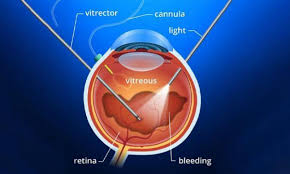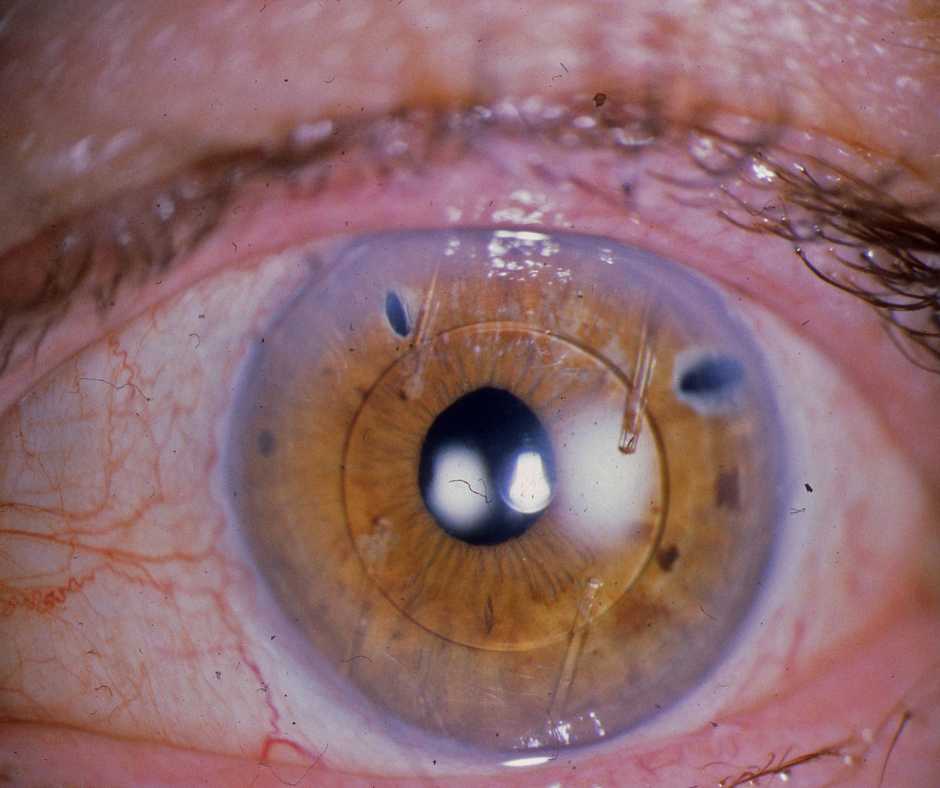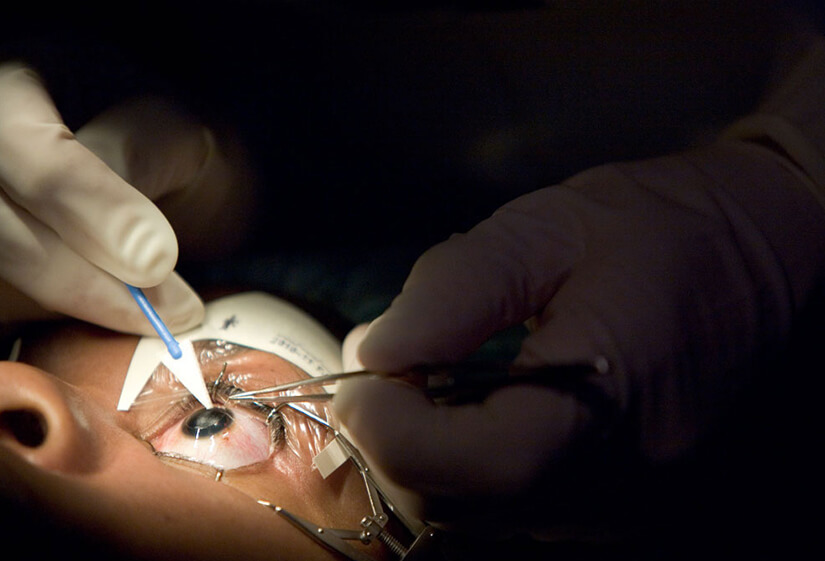Introduction
Surgeons perform vitrectomy as a crucial surgical procedure to treat a range of eye conditions affecting the retina and vitreous humor. The vitreous humor is a gel-like substance that fills the eye and supports the retina. Surgeons typically perform a vitrectomy when non-surgical methods cannot address issues with the vitreous or retina. This article provides an in-depth understanding of vitrectomy, covering its types, procedure, risks, recovery process, and more.

What is a Vitrectomy?
Surgeons perform a vitrectomy to remove the vitreous humor, the gel-like substance in the center of the eye, in order to treat various retinal disorders or vitreous abnormalities. They commonly use vitrectomy to repair retinal detachment, remove scar tissue, or clear blood or debris from the vitreous body that may affect vision. The surgery involves making small incisions and using specialized instruments, often performed on an outpatient basis under local anesthesia.
Why is it Performed?
Surgeons primarily perform vitrectomy to treat conditions that affect the retina or vitreous body of the eye. They use the procedure to correct issues such as:
- Retinal Detachment: When the retina separates from the back of the eye, leading to vision loss.
- Macular Hole: A small tear in the macula, the part of the retina responsible for central vision.
- Diabetic Retinopathy: A complication of diabetes that affects the blood vessels in the retina, potentially leading to vision impairment.
- Vitreous Hemorrhage: Bleeding into the vitreous body that can cloud vision.
- Epiretinal Membrane: Scar tissue that forms on the retina and distorts vision.
The procedure allows ophthalmologists to access the vitreous and retina to treat these conditions effectively, improving the chances of restoring or preserving vision.
Understanding the Vitreous Humor
Before diving deeper into the vitrectomy procedure, it’s essential to understand the role of the vitreous humor in the eye and the conditions that can affect it.
Role of the Vitreous Humor in the Eye
The vitreous humor is a clear, gel-like substance that occupies the space between the lens and the retina in the eye. It helps maintain the shape of the eyeball and plays a crucial role in supporting the retina in its proper position. It helps maintain the shape of the eye and supports the retina in its position at the back of the eye. It also plays a crucial role in transmitting light to the retina, where the retina processes it and sends the information to the brain to create visual images.
Conditions Affecting the Vitreous
Several conditions can affect the vitreous humor, and they may require vitrectomy for treatment:
- Vitreous Detachment: This occurs when the vitreous pulls away from the retina, leading to symptoms such as flashes of light or floaters in the vision.
- Vitreous Hemorrhage: This is the accumulation of blood within the vitreous body, which can cause vision loss and requires removal.
- Macular Hole: When a hole forms in the macula, the center of the retina responsible for sharp vision, surgeons can perform a vitrectomy to address the issue.
Who Needs a Vitrectomy?
Certain individuals are more likely to need a vitrectomy due to underlying eye conditions. Here are the most common eye conditions that may require a vitrectomy:
Common Eye Conditions Requiring Vitrectomy
- Retinal Detachment: The retina becomes detached from its normal position in the back of the eye, requiring surgery to reattach it.
- Macular Hole: A small tear or hole in the retina’s central part can lead to central vision loss.
- Vitreous Hemorrhage: Blood in the vitreous body caused by retinal conditions such as diabetic retinopathy or retinal vein occlusion can impair vision.
- Diabetic Retinopathy: Individuals with advanced diabetes may experience vision problems due to damaged blood vessels in the retina.
- Epiretinal Membrane: A thin layer of scar tissue can form on the surface of the retina, causing vision distortion and blurring.
Signs and Symptoms Indicating the Need for Surgery
If you experience symptoms such as sudden vision loss, flashes of light, or the appearance of numerous floaters, a vitrectomy may be necessary to address these concerns. Timely treatment can help preserve vision and prevent further damage.
Types of Vitrectomy Procedures
Surgeons choose different types of vitrectomy procedures based on the condition being treated and the location of the problem in the eye.
Pars Plana Vitrectomy (PPV)
Pars plana vitrectomy is the most common type of vitrectomy. In this procedure, the surgeon makes small incisions in the eye and uses specialized instruments to remove the vitreous humor. Surgeons commonly use it to treat retinal conditions such as retinal detachment, macular holes, and vitreous hemorrhage.
Anterior Vitrectomy
Surgeons perform anterior vitrectomy when the problem lies in the front of the eye, closer to the lens. They often use this procedure when damage to the vitreous body or lens requires removal to treat the condition effectively.
Preparing for Vitrectomy Surgery
Preparation for vitrectomy surgery is crucial for ensuring the best possible outcome. Here are some steps that may involve the process.
Preoperative Evaluation and Tests
Before the surgery, your ophthalmologist will perform a thorough evaluation to assess the health of your eye. This may include a dilated eye exam, ultrasound imaging, and tests to measure intraocular pressure. These tests help the surgeon plan the most appropriate course of action for your treatment.
Instructions for Patients Before Surgery
Your doctor will give you specific instructions, including fasting for several hours before the procedure and arranging transportation, as anesthesia may affect your ability to drive.
The Vitrectomy Procedure Step by Step
The vitrectomy procedure is a delicate and precise surgery, typically performed in an outpatient setting. Here is an overview of the steps involved:
Anesthesia and Patient Positioning
The surgeon administers local anesthesia to numb the eye, and in some cases, provides sedation for comfort. The surgical team positions the patient lying on their back and prepares the eye for the procedure.
Creating Incisions in the Eye
Small incisions are made in the sclera (the white part of the eye). These incisions allow the surgeon to insert tiny instruments, including a microscope and a laser, to view and work on the vitreous and retina.
Removal of the Vitreous Humor
The vitreous humor is gently suctioned out using specialized tools. This allows the surgeon to address any issues within the vitreous body, such as blood or debris.
Repairing the Underlying Issue
The surgeon will then repair the retinal detachment, remove scar tissue, or fix any other problems that are causing the condition.
Insertion of Gas, Oil, or Saline
In some cases, the surgeon may inject gas or silicone oil into the eye to help reattach the retina or hold it in place while healing occurs. The surgeon may also use saline solution to temporarily replace the vitreous humor.
Risks and Complications of Vitrectomy
Like any surgery, vitrectomy carries certain risks. While the procedure is generally safe, some common side effects and complications include:
- Infection
- Increased intraocular pressure
- Cataracts (particularly in older patients)
- Retinal detachment or macular edema
- Vision disturbances
Serious complications are rare but may include loss of vision or further retinal damage. Following post-surgery instructions and attending follow-up appointments can help reduce risks.
Recovery After Vitrectomy Surgery
The recovery process following a vitrectomy varies depending on the complexity of the procedure, but most patients can expect the following:
Immediate Post-Surgery Care
Post-surgery, the patient will need to rest and follow specific instructions to ensure proper healing. Some patients may need to maintain a face-down position for several days, especially if the retina needs to heal properly.
Medications and Eye Drops
Your doctor will prescribe medications to prevent infection and reduce inflammation. Eye drops may also be prescribed to keep the eye lubricated and promote healing.
Positioning Requirements (Face-Down Recovery)
The success rates for vitrectomy depend on the condition being treated, but many patients experience significant improvement in their vision after surgery.
Expected Vision Improvements After Vitrectomy
Timeline for Vision Recovery
Vision recovery can vary, with some patients noticing improvements within weeks and others taking several months. Factors such as the type of condition treated, age, and overall health can affect recovery time.
Factors Affecting Outcomes
Factors such as the severity of the eye condition, the patient’s overall health, and how well they follow postoperative care instructions influence successful outcomes.
Lifestyle Adjustments During Recovery
Restrictions and Precautions
During the recovery period, doctors may advise patients to avoid strenuous activities, bending over, or lifting heavy objects to prevent straining the eye.
When to Resume Daily Activities
Your doctor will provide guidelines on when it is safe to resume daily activities such as driving, working, and exercising.
Success Rates and Long-Term Outcomes
Vitrectomy surgery has a high success rate, especially when performed early in the disease process. The goal of surgery is to improve vision, although results may vary depending on the underlying condition.
How Successful is Vitrectomy?
The condition being treated affects the success rates for vitrectomy, but many patients experience significant improvement in their vision after surgery.
What to Expect in the Long Run?
Long-term outcomes depend on the specific condition treated, but most individuals can expect to maintain or improve their level of vision following a successful vitrectomy.
Vitrectomy Cost and Insurance Coverage
Factors Influencing the Cost
The cost of vitrectomy ranges from $2,000 to $10,000, depending on factors such as the procedure’s complexity, location, and whether the surgeon performs the surgery in a hospital or outpatient facility.
Does Insurance Cover Vitrectomy?
Most insurance plans, including Medicare, cover vitrectomy when it is deemed medically necessary. It is important to confirm your coverage with your insurance provider before surgery.
Alternatives to Vitrectomy Surgery
For certain conditions, there may be non-surgical treatments available, such as laser therapy or injectable medications. In some cases, additional surgical procedures, such as scleral buckling for retinal detachment, may be recommended.
Non-Surgical Treatments
- Laser Therapy: For conditions like diabetic retinopathy, laser treatments can help seal leaking blood vessels or prevent retinal detachment.
- Anti-VEGF Injections: These injections are used for macular degeneration and diabetic retinopathy to reduce swelling and prevent further damage.
Other Surgical Procedures
Surgeons may use alternative surgeries like scleral buckling or pneumatic retinopexy for conditions such as retinal detachment.
Conclusion
Vitrectomy is a vital procedure that can treat a variety of eye conditions affecting the retina and vitreous humor. While the recovery process requires patience and care, the surgery can offer significant benefits in terms of preserving and improving vision. If you are experiencing issues with your vision, consult an eye specialist to determine whether vitrectomy is the right course of action for you.
Author Details:
Dr. Sushruth Appajigowda holds a prominent position as a Cornea, Cataract, Glaucoma, and LASIK Surgeon in Bangalore. He serves as the chief Cataract and Refractive surgeon at Vijaya Nethralaya Eye Hospital, Nagarbhavi Bangalore. Renowned as one of the finest LASIK surgeons nationwide, he brings with him over 12+ years of experience across multiple LASIK platforms, including ZEISS, ALCON, SCHWIND, AMO, and Bausch and Lomb. Having successfully conducted over 5000 LASIK procedures, Dr. Sushruth holds the title of a Certified Refractive Surgeon and a Fellow of the All India Collegium Of Ophthalmology. Furthermore, he stands as a distinguished speaker at various National and International Forums, using his expertise to guide you in selecting the most suitable procedure based on your health requirements.

http://vijayanethralaya.com/link-in-bio/
FAQs About Vitrectomy
- How long does vitrectomy surgery take? A typical vitrectomy takes 1 to 2 hours, but the exact duration depends on the complexity of the procedure.
- Is the vitrectomy procedure painful? The procedure is generally not painful because local anesthesia is used. Some discomfort may occur during recovery, but it is usually manageable with medication.
- Can I drive after vitrectomy surgery? Patients are advised not to drive immediately following surgery due to blurred vision and the use of anesthesia.












